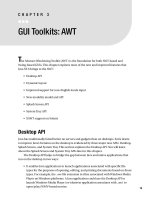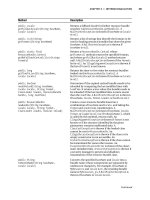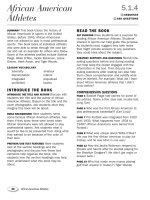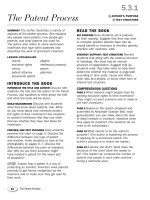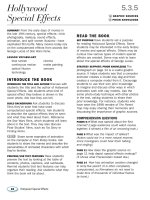- Trang chủ >>
- Mầm non - Tiểu học >>
- Lớp 5
5 6 3 from salt to silk precious goods (social studies) TG
Bạn đang xem bản rút gọn của tài liệu. Xem và tải ngay bản đầy đủ của tài liệu tại đây (132.17 KB, 4 trang )
5.6.3
From Salt to Silk:
Precious Goods
SUMMARY
This nonfiction selection explores
the history of salt, silk, gold, diamonds, and
oil. Obtaining and trading such precious goods
has had both good and bad consequences,
such as spreading ideas across cultures and
starting wars.
LESSON VOCABULARY
commodities
luster
microorganisms
preserve
excavating
malleable
molten
synthetic
INTRODUCE THE BOOK
INTRODUCE THE TITLE AND AUTHOR
Discuss with
students the title and author From Salt to Silk:
Precious Goods. Draw students’ attention to
the cover photo. Ask: What do you think this
selection will be about? The content triangle
says Social Studies; what does that suggest?
BUILD BACKGROUND Discuss with students
what they already know about the history
of precious goods such as gold or oil. Ask
students what news they have recently heard,
for example, about oil prices. Ask: Have any of
you seen an oil field, or pictures in the news of
an oil field? What are some of the uses of oil
today? Why is oil sometimes called black gold?
PREVIEW/USE TEXT FEATURES
Have students
read the title and spend a few minutes looking
at the photos, graphs, and maps. Discuss
what these suggest about the selection’s
content. Draw students’ attention, for
example, to the graph on page 19 and ask
them to discuss what this tells them about
oil use in the world.
120
COMPARE AND CONTRAST
ANSWER QUESTIONS
READ THE BOOK
SET PURPOSE
Guide students to set their own
purposes for reading the selection. Students’
interest in history or in a precious item such
as gold should guide this purpose. Suggest
that students imagine an item they value that
is scarce or hard for them to obtain.
STRATEGY SUPPORT: ANSWER QUESTIONS
Remind
students that good readers know where to
find the answers to questions about what
they read. They might find the answer in just
one sentence or in several places, or they
may need to use prior knowledge combined
with information from the text. Discuss with
students why answering questions quickly and
accurately is important to good reading. (It is
a valuable comprehension check and keeps
the reader focused on the topic.) As students
answer the following questions, have them tell
how they came up with their answers.
COMPREHENSION QUESTIONS
PAGE 3
What is one common factor that
makes salt, silk, gold, diamonds, and oil
precious? (At one time, they were all scarce
or hard to obtain.)
PAGES 10–11
What was one good result of the
silk trade? (China became linked to Europe,
and ideas were traded between cultures.)
PAGES 9 AND 18
How is the history of silk
similar to the history of diamonds? (Silk and
diamonds were each exclusive to one country
for centuries.)
PAGE 21
What do you think will happen if most
countries continue to meet their energy needs
with oil? (The struggle for oil control will
continue.)
From Salt to Silk: Precious Goods
16924_LRD_TG_120-121 120
12/16/05 9:11:23 AM
REVISIT THE BOOK
READER RESPONSE
1. Possible response: Silk: fabric woven from
thread of silkworm’s cocoon, no longer a
precious commodity; Diamonds: crystal
made of carbon, still a precious commodity;
Both: exclusive to one country for centuries
2. 1981
3. Harmless means “without harm,” while
harmful means “full of harm;”
worthless(ness), spoonful, beautiful, skillful(ly),
colorless
4. Responses will vary but should include
reasons.
EXTEND UNDERSTANDING
Ask students to look
at each of the regional maps in the article.
Then present either a world map or a globe
so that students can see where these regions
lie in relation to each other and have a global
picture of the various trade routes discussed
in the article.
RESPONSE OPTIONS
WRITING
Have students keep a journal for
several days in which they track every activity
that requires the use of oil, such as using a
microwave, watching TV, playing a computer
game, mowing the lawn, etc. Encourage
them to think beyond the obvious uses,
such as driving a car. Point out that many
commodities, such as clothing or electronics,
are made in factories powered by oil.
SOCIAL STUDIES
CONNECTION
Ask students to pick a
precious commodity not
mentioned in this selection, such
as water, and research its current uses
and trade routes. Invite students to research
the trade of a resource found in their region.
Encourage students to share their research
with others.
Skill Work
TEACH/REVIEW VOCABULARY
Reinforce comprehension by challenging
students to write sentences that use two
or more of the vocabulary words. Hold a
contest to see if anyone can combine all
the vocabulary words in one sentence.
Divide students into small groups
and have each group take turns in acting
out each vocabulary word.
TARGET SKILL AND STRATEGY
COMPARE AND CONTRAST
Remind
students that to compare and contrast is to
look for similarities and differences between
two objects, ideas, or pieces of text. Draw
students’ attention to the heads reading The
Value of Salt, The Value of Silk, and so on.
Point out that the author has organized the
entire text to underline the similarities and
differences among the precious goods.
ANSWER QUESTIONS
Remind students
that answering questions correctly will help
them monitor their comprehension. After
reading, have students work in pairs to ask
each other questions about the text. Have
them tell where they found or how they
came to the answer they provided.
ADDITIONAL SKILL INSTRUCTION
DRAW CONCLUSIONS
Remind students that
drawing a conclusion means making a
sensible decision or forming a reasonable
opinion after thinking about the facts and
details in what they have read. Drawing
conclusions helps students synthesize
what they have read, draw on their own
life experiences, and identify the author’s
purpose. Suggest that students make a list
of key facts in this selection and use them
to come to a reasonable conclusion.
From Salt to Silk: Precious Goods
16924_LRD_TG_120-121 121
121
1/10/06 5:54:12 PM
From Salt to Silk
Name
Compare and Contrast
• To compare is to tell how two or more things are alike. Authors may use clue words
and phrases such as similar to, like, or as to compare.
• To contrast is to tell how two or more things are different. Authors may use clue words
such as different from, but, unlike, on the other hand, or however to contrast.
Directions Read the passage below. Then compare and contrast the results of the desire for
these precious goods. How are the results similar throughout history and across the range of
goods? How are they different or specific to that particular item? Use the chart at the bottom
of the page to organize your answers.
O
ver 1,000 years ago, West African
realms became rich by selling salt,
as they were near salt mines. They had the
endless supplies of salt that the Europeans
wanted. Traders started trade routes from
the salt mines in the Sahara desert to the
Mediterranean Sea.
Similarly, Persian traders became very
rich selling silk. They could ask any price
they wanted for the precious fabric, which
only the Chinese knew how to produce.
Silk makers guarded their secret carefully
for about 3,000 years. Traders carried their
goods 5,000 miles across Asia on routes
that together were known as the Silk Road.
Ideas were traded along with the silk
and other goods. The desire for silk was
important in linking Europe to China.
Over 2,000 years ago, African invaders
entered Spain to take possession of its
gold. The invaders became rich, and many
Spanish people were forced to mine gold.
In North America of the 1840s, news of
gold attracted thousands of gold diggers.
The area grew so quickly that California
applied for statehood.
Diamonds have long been considered
precious. Today, armies that control
diamond-rich sections of their countries
use “conflict diamonds” to pay for their
wars.
The desire for oil, most of which is in
the Middle East, has also led to military
conflict and international struggles to
control oil resources.
Alike
Different
© Pearson Education 5
Results of Desire for Precious Goods
122
16924_LRD_TG_122-123 122
12/16/05 9:12:47 AM
From Salt to Silk
Name
Vocabulary
Directions Write the vocabulary word that matches each definition.
Check the Words You Know
commodities
excavating
luster
malleable
microorganisms
molten
preserve
synthetic
1.
adj. able to be shaped or formed as by hammering or pressure
2.
n. any things that are bought and sold
3.
n. soft reflected light; sheen
4.
adj. made liquid by heat; melted
5.
v. exposing or uncovering by digging out, as a mine
6.
adj. created by humans rather than found in nature; artificial
7.
n. organisms so small that they can only be seen with a
microscope, such as bacteria
8.
v. to prevent something, such as food, from decaying or spoiling
© Pearson Education 5
Directions Write a brief paragraph about one precious commodity listed in From Salt to Silk:
Precious Goods. Use as many vocabulary words as possible.
123
16924_LRD_TG_122-123 123
12/16/05 9:12:49 AM
